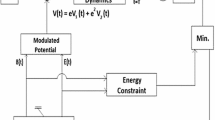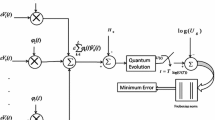Abstract
The aim of this paper is to design a current source obtained as a representation of p information symbols \(\{I_k\}\) so that the electromagnetic (EM) field generated interacts with a quantum atomic system producing after a fixed duration T a unitary gate U(T) that is as close as possible to a given unitary gate \(U_g\). The design procedure involves calculating the EM field produced by \(\{I_k\}\) and hence the perturbing Hamiltonian produced by \(\{I_k\}\) finally resulting in the evolution operator produced by \(\{I_k\}\) up to cubic order based on the Dyson series expansion. The gate error energy is thus obtained as a cubic polynomial in \(\{I_k\}\) which is minimized using gravitational search algorithm. The signal to noise ratio (SNR) in the designed gate is higher as compared to that using quadratic Dyson series expansion. The SNR is calculated as the ratio of the Frobenius norm square of the desired gate to that of the desired gate error.





Similar content being viewed by others
References
Nielsen, M.A., Chuang, I.L.: Quantum Computation and Quantum Information, p. 171286. Cambridge University Press, Cambridge (2001)
Shapiro, M., Brumer, P.: Quantum control of bound and continuum state dynamics. Phys. Rep. 425(4), 195–264 (2006)
Moghadam, M.S., Nezamabadi, H., Farsangi, M.M.: A quantum inspired gravitational search algorithm for numerical function optimization. Inf. Sci. 267, 83–100 (2014)
Barenco, A., Bennett, C.H., Cleve, R., DiVincenzo, D.P., Margolus, N., Shor, P., Sleator, T., Smolin, J.A., Weinfurter, H.: Elementary gates for quantum computation. Phys. Rev. A 52, 34573467 (1995)
Kumar, P., Skinner, S.R.: Using non-ideal gates to implement universal quantum computing between uncoupled qubits. Quantum Inf. Process. 12(2), 973–996 (2013)
Makhlin, Y.: Nonlocal properties of two-qubit gates and mixed states, and the optimization of quantum computations. Quantum Inf. Process. 1(4), 243–252 (2002)
Levi, D., Moshinsky, M.: Relations between hyperspherical and harmonic-oscillator many-body matrix elements. Il Nuovo Cimento A Series Springer 20(1), 107–114 (1974)
Benioff, P.: Quantum mechanical Hamiltonian models of Turing machines. J. Stat. Phys. 29(3), 515–546 (1982)
Deutsch, D., Jozsa, R.: Rapid solution of problems by quantum computation. R. Soc. Lond. Proc. A 439, 553–558 (1992)
Bernstein, E., Vazirani, U.: Quantum complexity theory. SIAM J. Comput. 26(5), 1411–1473 (1997)
Holland, J.: Adaptation in Natural and Artificial Systems. MIT Press, Cambridge, MA (1975)
Kirkpatrick, S.: Optimization by simulated annealing: quantitative studies. J. Stat. Phys. 34, 975–986 (1984)
Kennedy, J., Eberhart, R.: A new optimizer using particle swarm theory. In: Proceedings of the sixth international symposium on micro machine and human science, vol. 1, pp. 39–43 (1995)
Dorigo, M., Birattari, M., Stutzle, T.: Ant system: optimization by a colony of cooperating agents. IEEE Trans. Syst. Man Cybern. Part B Cybern. 26(1), 29–41 (1996)
Rashedi, E., Nezamabadi, H., Saryazdi, S.: GSA: a gravitational search algorithm. Inf. Sci. 179(13), 2232–2248 (2009)
Formato, R.A.: Central force optimization: a new metaheuristic with applications in applied electromagnetics. Prog. Electromagn. Res. 77, 425–491 (2007)
Gautam, K., Chauhan, G., Rawat, T.K., Parthasarathy, H., Sharma, N.: Realization of quantum gates based on three dimensional harmonic oscillator in a time varying electromagnetic field. Quantum Inf. Process. 14(9), 3279–3302 (2015)
Gautam, K., Rawat, T.K., Parthasarathy, H., Sharma, N.: Realization of commonly used quantum gates using perturbed harmonic oscillator. Quantum Inf. Process. 14(9), 3257–3277 (2015)
Altintas, A.A., Ozaydin, F., Yesilyurt, C., Bugs, S., Arik, M.: Constructing quantum logic gates using q-deformed harmonic oscillator algebras. Quantum Inf. Process. 13, 1035–1044 (2014)
Bartlett, S.D., Guise, H.D., Sanders, B.C.: Quantum encodings in spin systems and harmonic oscillators. Phys. Rev. A 65, 052316 (2002)
Dirac, P.A.M.: The Principles of Quantum Mechanics, 4th edn. Oxford University Press, New York (1958)
Divincenzo, D.P.: Two-bit gates are universal for quantum computation. Phys. Rev. A 51, 1015 (1995)
Hua, M., Tao, M.J., Deng, F.G.: Fast universal quantum gates on microwave photons with all resonance operations in circuit QED. Sci. Rep. 5, 9274 (2015)
Zhang, Y., Kauffman, L.H., Ge, M.L.: Universal Quantum Gates, Yang–Baxterizations and Hamiltonians. Quantum Inf. Process. 4, 159–197 (2005). doi:10.1007/s11128-005-7655-7
Altafini, C.: On the generation of sequential unitary gates from continuous time Schrödinger equations driven by external fields. Quantum Inf. Process. 1, 207–224 (2002)
Author information
Authors and Affiliations
Corresponding author
Appendices
Appendix 1
Consider Eq. (11),
where \(V_{1k}(t)\) is a first-order time-dependent linear partial differential operator in q (that is, the sum of a time-dependent function of q and a time-dependent vector field in q), while \(V_{2km}(t)\) is a function of \(q \,\text {and} \,t\), that is, a multiplication operator. The operators are defined as follows
where \(P=-i\frac{\partial }{\partial q}\) and \(V_{1k}(t)\,\text {and}\, V_{2km}(t)\) is given by
Now, consider
where
The pulses \(p_k\) have their meaning in Eq. (3).
Appendix 2
Consider Eq. (13),
where \(U_0,U_{1k},U_{2km}, U_{3kml}\) are operators that do not depend on the current amplitudes \(I_1,..., I_p\). In other words, these operators are expressible entirely in terms of the operators \(H_0,V_{1k}(t),V_{2km}(t)\) with the operators \(V_{1k}(t), V_{2k}(t)\) completely independent of \(I_1,..., I_p\), that is, expressible entirely in terms of the current pulses \(p_k(t)\) and the length vectors \(d\mathbf{{l}}_k. U_{1k}, U_{2km}\) and \(U_{3kml}\) are defined as follows.
and
Now \(W_{1k}, W_{2km}\,\text {and}\, W_{3kml}\) are defined, respectively, as
where \(\widetilde{V}_{1k}(t)= U_0(-t)V_{1k}(t)U_0(t)\) and similarly
where \(\widetilde{V}_{2km}(t)= U_0(-t) V_{2km}U_0(t)\) and
Appendix 3
where
and
with \(\widetilde{V}_k(t)=U_0^*(t)V_k(t)U_0(t)=U_0(-t)V_k(t)U_0(t), k=1,2\). Let \(|n\rangle ,\quad n=1,2,\ldots \) denote the energy eigenstates of \(H_0\) (so far the discussion is general, it is applicable to any non-relativistic charged particle moving in a time-invariant potential and excited by an electromagnetic field). Then, if \(H_0 |n\rangle = E_n |n\rangle , n=1,2\) it follows that
Thus \(F_1[n,m]= \sum _k I_k G_{1k}[n,m]\), where
similarly, we can write
where
Finally
where
The notation E(n, p) can be used in this way \(E(n,p)=E_n-E_p\). Equivalently we can write
It should be noted that \(F_k[n,m]\) are, respectively, the matrix elements of the operator \(F_k\) defined in Eqs. (81), (82) and (83), where \(G_{1k}, G_{2kr}, G_{3krs}\) are the matrix coefficients of \(I_k, I_kI_r, I_kI_rI_s\) in \(F_1, F_2, F_3\), respectively.
Rights and permissions
About this article
Cite this article
Sharma, N., Rawat, T.K., Parthasarathy, H. et al. Realization of a quantum gate using gravitational search algorithm by perturbing three-dimensional harmonic oscillator with an electromagnetic field. Quantum Inf Process 15, 2275–2302 (2016). https://doi.org/10.1007/s11128-016-1270-7
Published:
Issue Date:
DOI: https://doi.org/10.1007/s11128-016-1270-7




